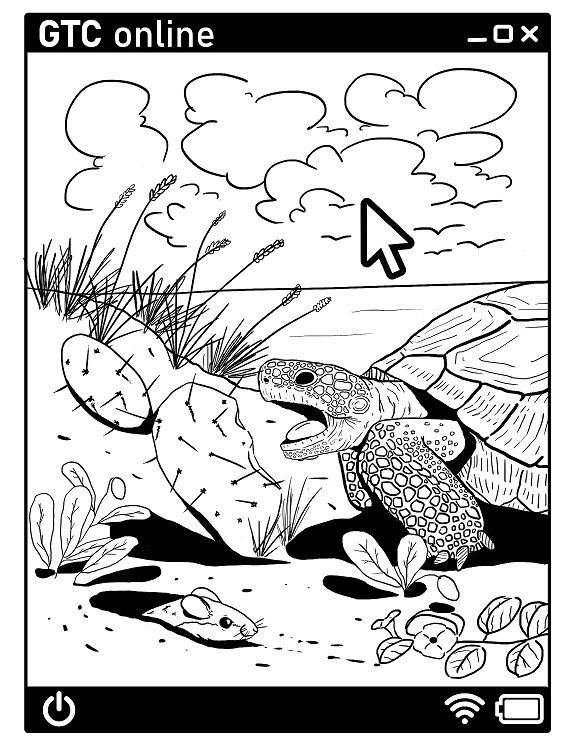Volume 41, Number 3
Dear members,
Earlier in 2021, I did not think that I would be reporting on a second virtual Annual Meeting. However, over the course of the past two years, we have likely all been shocked by the pandemic-imposed challenges on many aspects of our lives; we have also all heard of unexpected successes and resiliencies, despite these challenges. I would like to address the latter, and celebrate the successes for which this organization should be proud. At this past year's virtual conference, we had a total of 203 individuals join our meeting. This total was approximately a 30% increase in conference attendance from our previous records. It should be clear to that Gopher Tortoise Council has a growing and vibrant membership! I hope to see this increased participation grow in the new year and sustain future records for in-person annual meetings. At the virtual meeting, we announced a total of over $8,000 in grants awarded to highly qualified students and environmental education facilities through the Landers and Heinrich awards. More highlights from this year's meeting are featured throughout the Winter 2021 newsletter.
Extremely generous donors paired with low overhead costs of virtual meetings have left Gopher Tortoise Council in the best financial shape to date. With this great news, we have increased the expected award amounts for our Landers student research grants. We have also changed the due date for the Landers award to February 11th in an effort to make this grant more accessible to student schedules. In light of the date change that is taking effect this year, we will have given out two separate rounds of student awards in one year! So, please, encourage yourself, your students, and/or your friends and colleagues to apply for one of these awards. Also, in light of our strong financial position, the Board is exploring additional ways of funding targeted special projects in conservation research. We will also be targeting financial support to Gopher Tortoise Day celebrations which is April 10th every year! Check out the "Gopher Tortoise Council Environmental Education Grants Updates for 2022" article in this newsletter for more details on new grant opportunities. All of these developments within our organization are successes that speak to the great work of our board and a highly engaged and generous membership.
Under the ever-growing pressure to develop upland habitats across the southeastern coastal plains, we know that the challenges facing gopher tortoises and the hundreds of associated species are not going to simply dissolve in the new year. I look forward, however, to seeing this organization continue to grow and lead in the conservation and research community. I believe that we must continue to advocate for science-based management and policies. When we as a community and organization hold fast to this conservation imperative, we will most closely approach the shared goals of our broad membership.
Thank you to the board for their continued and tireless work in running this volunteer organization, and thank you to all of our members and donors for their continued support.
Wishing you peace, health, and an abundance of nature in your New Year!
Sincerely,
Jeff Goessling
Outgoing Co-chair

Thank you to all participants and presenters for helping make the 43rd Annual Gopher Tortoise Council Meeting a success! Keep reading for highlights from the meeting.

Click to read more about the critical gopher tortoise conservation being done across the species' range in our 2021 state report summaries.
By Laura Greeno, Natural Areas Coordinator, Lee County Parks & Recreation

Funding provided by the Donna J. Heinrich environmental education grants allowed Lee County Parks and Recreation staff to increase awareness of the importance of gopher tortoise and upland conservation through printing of a coloring book, development of an interpretive sign and interaction with elementary school children. By partnering with school staff, we were able to complete the project despite COVID restrictions prohibiting county staff from entering schools.
The Gopher Tortoise Council (GTC) would like to announce up to $13,000 in funding for locally-focused environmental education grants and project reimbursements that will be available under the 2022 Grant Program. GTC is proposing to award up to $5,000 under the Heinrich Environmental Education Grant, up to $4,000 in community outreach grant programs (example, gopher tortoise day programs), and up to $4,000 in a general reimbursement fund for existing or proposed programs and projects that need minor funding to help with printing or production costs.
Learn more about these new programs and their application guidelines at https://gophertortoisecouncil.org/grant-programs.
The 2022 Environmental Education Grant Programs will include support for projects that reflect the intersection of conservation for gopher tortoises, upland commensal species, and their associated habitat. The purpose of increasing funding is to improve public awareness of those topics and to provide financial support for projects or programs that design, demonstrate, and/or disseminate environmental education practices that increase environmental literacy and help participants develop skills needed to make informed decisions regarding conservation of upland habitats.
If you have any questions, please reach out to This email address is being protected from spambots. You need JavaScript enabled to view it. and please stay tuned for the additional funding and grant application announcements.
In late November 2021, the Executive Committee of the Gopher Tortoise Council issued this response to the recent FWC Executive Order EO 21-27 regarding gopher tortoise recipient capacity and relocation permits. Becca Cozad, Senior Co-Chair of the Gopher Tortoise Council, also provided comments at the FWC December 2021 Commission Meeting on this issue.
Some recently published articles about gopher tortoises and upland communities in the Southeast. Also check out GTC's Education & Outreach for more literature, including snake and tortoise bibliographies!
